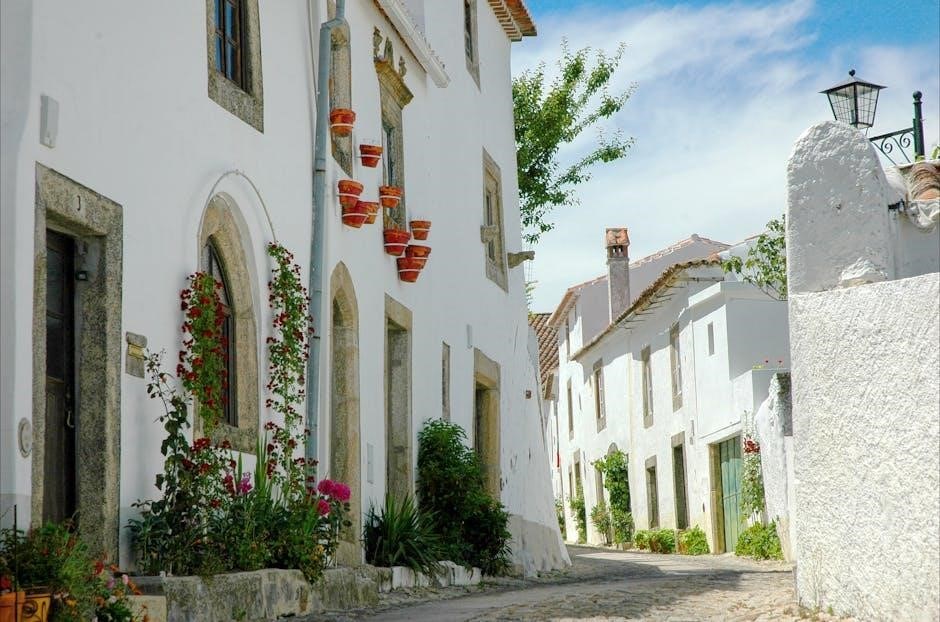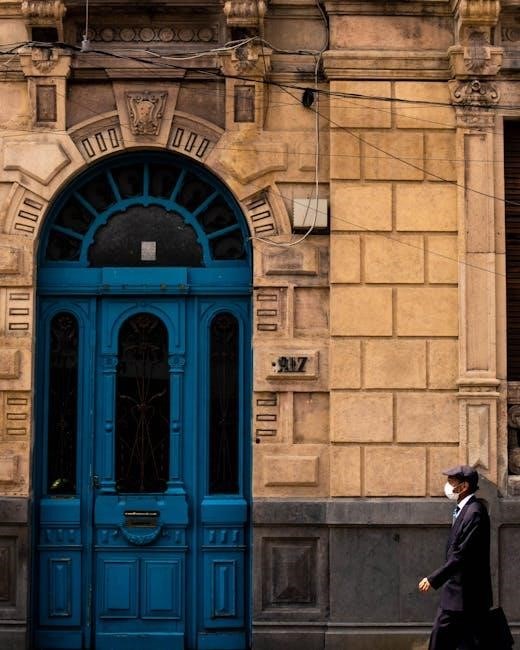The House on Mango Street by Sandra Cisneros is a poignant coming-of-age novel told through Esperanza Cordero’s eyes, exploring themes of identity, culture, and belonging.
Published in 1984, this modern classic has become a cornerstone of contemporary literature, celebrated for its lyrical prose and its universal resonance across generations and cultures.
Overview of “The House on Mango Street”
The House on Mango Street is a captivating novel by Sandra Cisneros, published in 1984. The story follows Esperanza Cordero, a young Latina girl, as she navigates her life in a new home on Mango Street in Chicago.
Told through a series of interconnected vignettes, the book explores themes of identity, culture, and belonging. Esperanza’s journey reflects her struggle to find her place in a world shaped by societal expectations and familial traditions.
The novel’s lyrical prose and poignant storytelling have made it a beloved classic, resonating with readers of all ages. Its universal themes and relatable protagonist have cemented its place in contemporary literature, celebrating the resilience and hope of a young girl’s spirit.
Author Sandra Cisneros
Sandra Cisneros is a celebrated Mexican-American writer, poet, and educator. Born on December 20, 1954, in Chicago, Illinois, she grew up in a bilingual household, which deeply influenced her writing style. Cisneros gained widespread acclaim with the publication of The House on Mango Street in 1984, a novel that has become a cornerstone of Chicana literature. Her work often explores themes of identity, culture, and feminism, resonating with readers globally. Cisneros has authored several other notable works, including Caramelo and The House on Mango Street, and has received numerous awards for her contributions to literature, including the MacArthur Fellowship. Her writing continues to inspire new generations of readers and writers alike.
Publication and Editions
The House on Mango Street was first published in 1984 by Arte Público Press, marking a significant milestone in Chicana literature. The novel gained widespread recognition and was later reissued in 1991 by Vintage Contemporaries, solidifying its place as a modern classic. Over the years, the book has been released in multiple editions, including paperback, hardcover, and anniversary editions, making it accessible to a broad audience; Its enduring popularity has led to translations into numerous languages, reaching readers worldwide. With over 6 million copies sold, it remains a beloved and influential work. The 40th-anniversary celebration in 2024 highlights its lasting impact on literature and culture. The book’s timeless themes continue to resonate with readers of all ages.

Plot Summary
The House on Mango Street follows Esperanza Cordero as she navigates life on Mango Street in Chicago, exploring themes of identity, family, and cultural expectations through vivid vignettes.
Setting: Mango Street and Chicago
The House on Mango Street is set in the vibrant yet challenging environment of Chicago’s Hispanic quarter, where Esperanza Cordero navigates her formative years. The titular Mango Street serves as both a physical and emotional backdrop, symbolizing Esperanza’s desire for a better life beyond its confines. The house itself, while theirs, falls short of the family’s expectations, reflecting their socio-economic struggles. Chicago’s diverse cultural landscape plays a crucial role in shaping Esperanza’s identity, as she grapples with her heritage and belonging. The setting seamlessly blends the warmth of community with the harsh realities of urban life, creating a rich tapestry that underscores Esperanza’s journey of self-discovery and growth. The street becomes a metaphor for both confinement and the promise of escape.

Esperanza Cordero: The Protagonist
Esperanza Cordero is the vibrant and introspective protagonist of The House on Mango Street, a young Latina girl navigating the complexities of adolescence. Her name, meaning “hope” in Spanish, reflects her desire for a brighter future. Esperanza’s journey is marked by her struggles with identity, cultural heritage, and belonging. Through her eyes, readers experience the challenges of growing up in a marginalized community, where societal expectations often clash with personal aspirations. Her voice, both poignant and powerful, captures the essence of self-discovery, making her one of literature’s most relatable and enduring characters. Esperanza’s story resonates universally, transcending cultural boundaries and speaking to the heart of adolescent struggles and dreams. Her evolution throughout the novel underscores the resilience of the human spirit in the face of adversity.
Family and Home Life
Esperanza’s family and home life are central to her story, shaped by financial struggles and cultural traditions. The Cordero family moves frequently, finally settling into a small house on Mango Street, which is theirs but not the home they dreamed of. Esperanza feels a deep connection to her family yet struggles with the limitations imposed by their circumstances. Her parents’ sacrifices and the close-knit nature of their household are evident, but so are the tensions and unspoken expectations. The house on Mango Street symbolizes both belonging and displacement, reflecting Esperanza’s ambivalent feelings about her family’s history and her own aspirations for a different future. This duality shapes her identity and fuels her desire for independence.
The Journey to Self-Discovery
Esperanza’s journey to self-discovery is a central theme in The House on Mango Street. Through a series of vignettes, she navigates childhood innocence, cultural expectations, and personal identity. Her experiences on Mango Street expose her to both joy and heartbreak, shaping her understanding of herself and her place in the world. Esperanza grapples with societal norms, family traditions, and her own desires, gradually forming a sense of self. Her evolving perspective reflects the challenges and triumphs of growing up, as she learns to reconcile her heritage with her aspirations. This journey is marked by moments of clarity and confusion, ultimately leading her toward a deeper understanding of who she is and who she wants to become. Her story resonates universally, offering a powerful exploration of adolescence and identity.

Themes and Motifs
The House on Mango Street explores themes of identity, belonging, and cultural heritage, alongside motifs of isolation and empowerment, weaving a rich tapestry of Esperanza’s emotional journey.
Identity and Belonging
Esperanza’s journey in The House on Mango Street revolves around her struggle to find her place in the world. Growing up in a Latino neighborhood in Chicago, she grapples with her dual identity, caught between her Mexican heritage and her American surroundings. Her name, which means “hope” in both languages, symbolizes her desire for a brighter future. Esperanza feels a deep sense of displacement, neither fully belonging to Mango Street nor to the wider world beyond. Through her experiences, Cisneros highlights the universal quest for self-definition and the challenges of bridging cultural divides, resonating deeply with readers of all backgrounds.
Cultural Heritage
The House on Mango Street deeply explores Esperanza’s connection to her Latino heritage, blending Mexican traditions with her American upbringing. Her name, meaning “hope” in both English and Spanish, reflects her dual identity. The vibrant vignettes of Mango Street capture the richness of her cultural surroundings, from the Spanish-speaking neighborhood to the shared stories of her family’s history. Cisneros weaves in elements of language, food, and customs, highlighting Esperanza’s pride in her roots while navigating the challenges of cultural duality. This interplay of heritage and assimilation creates a powerful narrative of self-discovery, resonating with readers who have experienced similar journeys of cultural identity and belonging.
Gender Roles and Expectations
The House on Mango Street examines the societal expectations placed on women and girls in Esperanza’s community. Esperanza observes the constraints imposed on females, such as limited career opportunities and the pressure to marry young. Characters like Sally and Rafaela embody these struggles, trapped by traditional gender roles that stifle their potential. Esperanza, however, resists these norms, aspiring to a future where she can define her own identity and escape the confines of societal expectations. Sandra Cisneros’ portrayal of gender roles highlights the tension between cultural traditions and individual aspirations, offering a feminist perspective on the challenges faced by women in Latino communities. This theme resonates deeply, encouraging readers to reflect on gender equality and personal freedom.
Coming of Age
The House on Mango Street is a powerful coming-of-age story that follows Esperanza Cordero as she navigates the challenges of adolescence. Esperanza’s journey is marked by her desire for independence, self-discovery, and understanding of her place in the world. Through her experiences on Mango Street, she grapples with themes of identity, culture, and belonging, all while transitioning from childhood to adulthood. The novel captures her struggles with innocence, friendship, and the complexities of growing up, particularly as a Latina in a patriarchal society. Esperanza’s ultimate realization of her need to define herself and find her own voice underscores the universal struggle of adolescence, making her story relatable and enduring. This theme is central to the book’s appeal and resonance with readers of all ages.

Character Analysis
The House on Mango Street delves into Esperanza Cordero’s journey, portraying her growth, family dynamics, and the neighborhood’s influence on her identity and self-discovery.
Esperanza Cordero: Growth and Development
Esperanza Cordero, the protagonist, undergoes significant personal growth throughout The House on Mango Street. Initially, she feels disconnected from her new home and struggles with her identity. As the novel progresses, Esperanza begins to assert her individuality, challenging traditional gender roles and societal expectations. Her experiences with family, culture, and friendships shape her understanding of herself and her place in the world. By the end of the book, Esperanza emerges as a confident young woman with a clearer vision of her future, symbolizing the journey of self-discovery and empowerment.
Key Family Members
In The House on Mango Street, Esperanza’s family plays a pivotal role in shaping her experiences. Her parents, Mama and Papa, embody traditional roles, with Mama being nurturing yet burdened by societal expectations, and Papa working tirelessly to provide for the family. Esperanza’s brothers, Carlos and Kiki, are protective yet distant, while her younger sister, Nenny, represents innocence and youthful curiosity. Each family member contributes to Esperanza’s understanding of identity, culture, and responsibility, influencing her journey toward self-discovery. Their dynamics reflect the challenges and strengths of a close-knit, working-class family navigating cultural and personal complexities.
Neighborhood Influences
The neighborhood on Mango Street profoundly shapes Esperanza’s perspective and identity. The vibrant yet challenging environment, filled with diverse characters, exposes her to the complexities of culture, class, and belonging. Neighbors like the Three Sisters, Cathy, and the cat lady offer glimpses into different lives, influencing Esperanza’s understanding of her own place in the world. The street itself becomes a character, symbolizing both confinement and connection. The neighborhood’s collective stories and struggles resonate deeply with Esperanza, fostering her desire to transcend her circumstances while remaining rooted in her community. These influences are central to her journey of self-discovery and her evolving sense of home and identity.
Cultural Icons and Symbols
The House on Mango Street is rich in cultural icons and symbols that reflect Esperanza’s heritage and identity. The house itself serves as a central symbol, representing both belonging and confinement. The color red, often associated with emotions and cultural vibrancy, appears frequently, symbolizing passion and resilience. The Virgen de Guadalupe is a recurring cultural icon, embodying spirituality and the strength of Latinx women. Music and dance, like the polka, highlight the blending of traditions. These symbols weave together Esperanza’s experiences, connecting her to her roots while inspiring her to carve her own path. They play a pivotal role in her journey, helping her navigate the intersection of culture, family, and self-discovery.
Reception and Legacy
The House on Mango Street has achieved critical acclaim and enduring popularity, celebrated for its vivid storytelling and universal themes. Marking its 40th anniversary, it remains a cherished classic.
Critical Acclaim and Reviews
The House on Mango Street has garnered widespread critical acclaim for its lyrical prose and profound exploration of identity, culture, and coming-of-age themes. Reviewers praise Sandra Cisneros’ ability to craft vivid, relatable vignettes that resonate deeply with readers. The novel’s intimate narrative voice, through Esperanza’s perspective, has been celebrated for its authenticity and emotional depth. Critics highlight its accessibility and universal themes, making it a beloved choice for both academic and casual readers. The book’s enduring popularity is evident in its inclusion in school curricula and its celebration during its 40th anniversary, further solidifying its place as a modern literary classic.
40th Anniversary Celebration
The House on Mango Street marked its 40th anniversary in 2024, celebrating its enduring impact on literature and readers. Sandra Cisneros joined events like the PBS Books National Book Festival, reflecting on the novel’s timeless themes. Readers worldwide shared their connections to Esperanza’s journey, highlighting the book’s universal resonance. The anniversary also featured adaptations, including an opera, showcasing the story’s versatility. Sandra Cisneros expressed gratitude for the book’s legacy, noting its continued relevance in exploring identity and culture. This milestone underscored the novel’s role in shaping modern literature and inspiring new generations of readers and writers, cementing its place as a cherished classic.
Impact on Literature and Readers
The House on Mango Street has left an indelible mark on literature, resonating with readers of all ages and backgrounds. Its vivid portrayal of Esperanza’s journey has inspired countless young readers, particularly those from marginalized communities, to reflect on their own identities and aspirations. The novel’s accessible, lyrical prose has redefined how coming-of-age stories are told, making it a staple in educational curricula. Its exploration of cultural heritage and universal themes has fostered empathy and understanding, solidifying its place as a modern classic. The book’s influence extends beyond literature, empowering readers to embrace their uniqueness and find their voice, ensuring its legacy as a transformative work in contemporary storytelling.

Educational Significance
The House on Mango Street is widely taught in schools, valued for its exploration of identity, culture, and social issues, making it a powerful educational tool.
Teaching the Book in Schools
The House on Mango Street is widely incorporated into school curriculums for its relatable themes of identity, culture, and self-discovery, resonating with diverse student experiences.
Teachers often use the book to explore complex social issues, fostering discussions on gender roles, class, and belonging. Its vignette structure makes it accessible for younger readers, while its depth encourages critical thinking.
Lesson plans frequently include creative projects, such as writing personal vignettes or analyzing cultural symbols, helping students connect with Esperanza’s journey. The book’s universal themes promote empathy and understanding.
Its inclusion in educational settings highlights its value as a tool for teaching literary analysis, cultural awareness, and the importance of storytelling in shaping individual and collective identities.
Lesson Plans and Activities
The House on Mango Street inspires engaging lesson plans that encourage students to explore its themes and literary style. Activities often include reading guides, creative writing prompts, and discussions on identity and culture.
Teachers incorporate projects like mapping Esperanza’s neighborhood, analyzing symbols, and creating personal vignettes. Group discussions focus on themes like belonging and family, fostering empathy and understanding.
Interactive activities, such as character analysis and theme-based art projects, deepen students’ connections to the text. These exercises help students develop critical thinking and creative expression while exploring Esperanza’s journey.
Lessons often extend beyond the classroom, with community projects that reflect the book’s themes, making learning meaningful and impactful.
Study Guides and Resources
Study guides for The House on Mango Street provide comprehensive analysis, summaries, and discussion questions to deepen understanding of the novel. These resources often include character maps, theme breakdowns, and literary device explanations.
Available in PDF formats, many guides cater to students and educators, offering insights into Esperanza’s journey and the cultural context. Additional resources include vocabulary lists, essay prompts, and reading comprehension exercises.

Interactive study tools, such as quizzes and discussion forums, further enhance learning. These resources help readers explore themes like identity, family, and belonging, making the novel accessible and engaging for diverse audiences.
Digital platforms and educational websites offer downloadable materials, ensuring easy access for both classroom and independent study. These guides are invaluable for analyzing Cisneros’ lyrical prose and the novel’s enduring relevance.


Adaptations and Interpretations
The House on Mango Street has inspired an opera adaptation, audio interpretations, and visual art, showcasing its cultural and artistic influence across various mediums.
Opera Adaptation
The opera adaptation of The House on Mango Street brings Esperanza’s journey to life through music and theater, capturing the emotional depth of her story.
Sandra Cisneros collaborated with the Glimmerglass Festival for a workshop performance, showcasing the novel’s themes of identity and culture in a new artistic form.
This adaptation highlights the universality of Esperanza’s experiences, offering audiences a fresh way to connect with her struggles and aspirations.
By blending lyrical prose with operatic expression, the adaptation honors the original work while introducing it to a broader audience.
Audio and Visual Interpretations
The House on Mango Street has inspired various audio and visual interpretations, enriching its storytelling through diverse mediums.
From audiobook adaptations to educational podcasts, Esperanza’s journey is brought to life, making the novel accessible to a wider audience.
Visual interpretations, such as graphic novel-inspired art and student-created projects, capture the vivid imagery of Mango Street and its characters.
These interpretations not only honor Sandra Cisneros’ original work but also encourage creative engagement with the themes of identity and culture.
Such multimedia approaches highlight the timeless relevance of Esperanza’s story, ensuring its continued impact across generations.
Cultural and Artistic Influences
The House on Mango Street reflects Sandra Cisneros’ Mexican-American heritage, blending cultural traditions and personal experiences into a vivid narrative.
The novel’s exploration of identity and belonging resonates deeply with readers from diverse backgrounds, making it a cornerstone of multicultural literature.

Cisneros’ lyrical prose and poignant vignettes have inspired artists, writers, and educators, fostering creative adaptations and interpretations.
The book’s influence extends beyond literature, impacting visual arts, music, and theater, with projects like the opera adaptation showcasing its universal appeal.
By celebrating cultural richness and individual storytelling, The House on Mango Street continues to inspire new generations of artists and thinkers.
Its legacy underscores the power of literature to bridge cultures and ignite creativity across mediums.